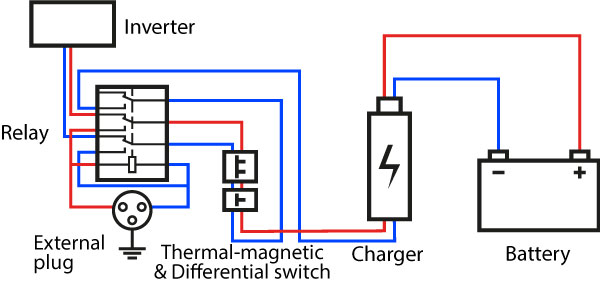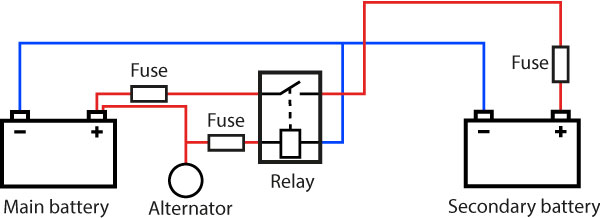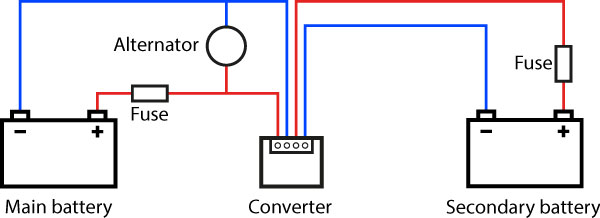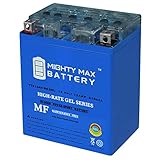If you are thinking of buying a gel battery to use it as an auxiliary battery in your van, we want to support you in your decision Gel batteries are a great option! If you have arrived here looking for more information to be able to choose the type of battery that suits you best, in our website you will find a lot of information that will help you not to make a mistake.
Solar gel batteries and their most important characteristics
The gel batteries are one of the most used to install as auxiliary battery in the vans camperized, since they offer a very good performance and have a longer life than other types of battery. Their most significant feature is that they are manufactured with a gel electrolyte. In addition, they are completely sealed so they do not emit gases and can be used without problems in places without any ventilation.
Want to buy a gel battery for your van on Amazon?
What is the performance of gel batteries?
Regarding their performance, gel batteries respond very well to rapid discharges and are resistant in partial states of charge, so they are a very good choice for solar installations, where a controlled charge cannot be performed because it is highly dependent on the weather. In addition, they have a minimum self-discharge rate, much lower than other types of batteries, and can generally retain 80% of their charge for more than 1 year, which makes them perfect for seasonal use.
How long does a gel battery last?
Gel batteries are able to withstand about 800 charge and discharge cycles, so they have a fairly long life. If a correct use is made of it, respecting its discharge limits and with quality charges, to the suitable voltage, they can reach about 12 years of useful life, that is to say, that they have a quite greater duration in comparison with other type of batteries.
How to install a gel battery?
With this type of solar batteries there is no danger of spillage of any liquid in case of overturning, so they can be installed in any position, which allows a better adaptation to the available space. However, it is recommended that, whenever possible, they should be installed with the terminals facing upwards, which is their natural position, to improve their performance and extend their useful life.
How can they be charged and is a specific charger required?
In your van you can charge your gel battery, like any other battery, through the 3 most commonly used methods in a camper or motorhome:
Charging a gel battery through solar panels
Installing a solar panel on your van or motorhome, for us, is something almost mandatory, especially if you are not visiting campgrounds or motorhome areas. Solar energy can give us a freedom and autonomy that, literally and once the initial outlay has been made, is priceless! What better than to be a little more self-sufficient by taking advantage of a free and clean natural resource?
To charge the battery using solar energy you will have to have, logically, a solar panel and a solar regulator, preferably a MPPT regulator (see on Amazon). In addition, the solar regulator must be able to charge at the appropriate intensity for the model of gel battery you have and at the recommended voltage in each of the phases of the charge. There are regulator models that have default settings for each type of battery, but they are not configurable, so you should check that the regulator’s charging powers, according to the charging phase, are adequate. On the other hand, a gel battery should never be equalized.

Charging a gel battery using a battery charger
Like the solar regulator, the battery charger (see on Amazon) must allow to select the type of battery to be charged or to set the charging voltage in the different phases, since gel batteries must be charged at lower voltages than traditional lead-acid batteries. Charging at voltages suitable for flooded lead-acid batteries would compromise their service life and could even cause irreparable damage to the battery. In addition, a gel battery should not be equalized. Our recommendation is the Victron Energy smart battery charger (see on Amazon), remember to purchase a charger suitable for the capacity of your battery.

Charging a gel battery via the main battery or alternator
To charge the battery using the main battery or the alternator of your vehicle you can do it by means of:
- A battery separator relay (see on Amazon) that can be manual or automatic and that will connect the auxiliary battery with the main battery of the vehicle. Depending on the model, when the relay detects that there is a charging voltage higher than its ignition voltage value, between 13 and 13.8V, or when it receives current on its activation pin, it will activate and connect the batteries. It will disconnect when this voltage drops or when the activation pin is no longer energized.

It is advisable to install a switch to be able to disconnect the relay and the batteries before turning off the vehicle or when you circulate with the auxiliary battery already charged. Remember to activate it, if you need to charge your battery, when the engine of your van is already running and always deactivate it before switching off the engine. If you forget and leave it connected when the vehicle is off, you can jeopardize both the charge and the life of the main battery.
- A converter (see on Amazon) or a booster converter which are devices capable of delivering a stable and specific voltage, which can be set between 10 and 15V, from an input current with a voltage that can vary within the accepted range, which is usually between 10 and 17 V for devices working at 12V. In addition, they usually incorporate a staged charging algorithm to properly charge the battery to extend its lifetime. This way of charging is the one we like the most. If you can afford a converter, we recommend installing it without any doubt.

In our opinion, the best way to charge an auxiliary battery in a camper van is a combination of a solar panel + MPPT regulator and a converter or booster. If you usually spend time parked and enjoying a place, you don’t have to worry, as the solar panel will be charging your battery. While the alternator and booster will kick into action when the engine is running, this could be an “emergency” charging method when the days are very cloudy or very short during the winter.
The charger with the external socket seems to us to be a great option for those van owners who like to visit or spend the night at campgrounds.
Recommended charging voltages in a gel battery
| ABS (absorption) | FLOAT | STORAGE | RECONDITION Max V at % of Inom |
|---|---|---|---|
| 14,4V | 13,8V | 13,2V | 16.2V at 8 % max. 1 h |
Remember that a gel battery should never be equalized.
Do gel solar batteries need maintenance?
The gel electrolyte improves their resistance to evaporation, vibrations and high temperatures. Also, since they are completely sealed, liquid loss due to spills and gas emissions are prevented. For all these reasons, gel batteries do not require any type of maintenance or periodic checks of their electrolyte levels.
Advantages of 12V gel batteries
- Very durable, they withstand a large number of charge and deep discharge cycles.
- The gel electrolyte does not evaporate, so they perform at 100% for a longer period of time.
- They are 100% hermetic, so they do not emit gases and there is no risk of spills.
- They are deep cycle.
- Although it is recommended that they are installed in their normal position, they can be placed in any other position.
- They do not require maintenance.
- They charge faster than AGMs.
- They have a much lower self-discharge rate than other types of batteries.
- Resist extreme temperatures better than other types of batteries.
- Very good response in fast discharges.
- They are cleaner since they are watertight and there is no possibility of spills.
Disadvantages of the gel batteries 12V
- Higher price than AGM and flooded lead-acid batteries.
- They should not be connected in parallel.
Final opinions and conclusions of Gel batteries and their price
It is true that these batteries are more expensive than the AGM, but we believe that, if you can afford a gel battery, it is the best option in relation quality-price to install in a camper van. They have a very good price-performance ratio for this use and thanks to their greater durability and resistance you will be able to amortize that slightly higher investment, compared to AGM. On the other hand, if you are hesitating between a gel battery and an flooded lead-acid battery to install inside your van, our recommendation is that, if you can afford it, install a sealed battery, either gel or AGM. For us, just not having to worry about good ventilation to avoid risks due to gas emissions is worth it.
All the schemes shown here are merely orientative. Always consult the documentation of the manufacturer of your devices because there may be variations.
Frequently asked questions from users about gel batteries
Finally, we want to collect in this section the questions that the users ask us and that we believe that they can be useful for the rest of the community. If you think that some question must be in this section, do not hesitate to write to us.
The price of a gel battery will depend on its brand and capacity. Roughly speaking, it could be said that the cost of a gel battery of about 100Ah could be around 210 €, depending on the brand.
Both gel and AGM batteries are hermetically sealed, so there is no liquid spillage when they are laid down. Contrary to what many recommend, a gel or AGM battery, even if it can, should not be installed lying down as both the performance and life of the battery will be affected. Therefore, for maximum safety, install them in their natural position whenever possible.
There is no problem in charging a battery from the alternator as long as you install a DC converter or some device that allows you to regulate the output voltage. In order to charge properly and not compromise the life of the battery, this type of battery requires a lower charging voltage than that delivered by an alternator.










